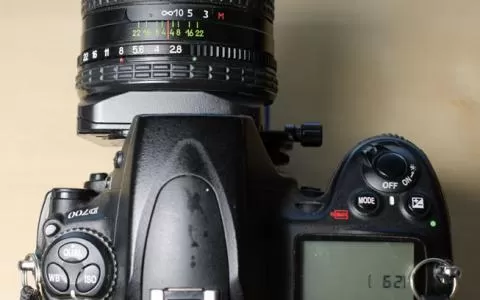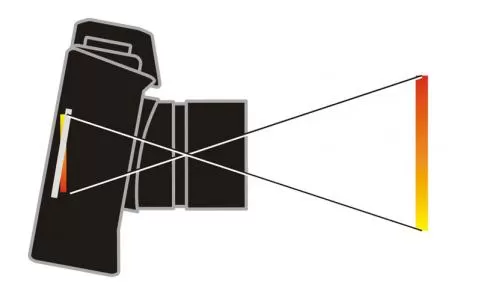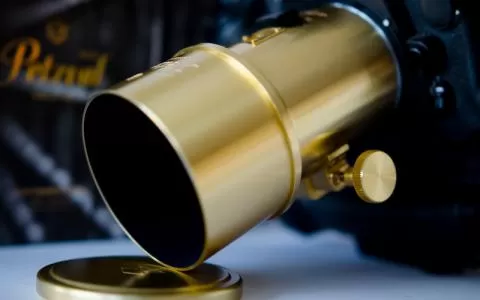So you want pictures that are low quality and trashy in a cool and trendy way? Time to get a hold of some odd gear to put in front of your SLR.
We photographers usually strive for the best and sharpest images. Usually.
But if you want to be trendy and artsy in a cool, underground, hipster way, sharp images just don't seem to cut it.
You will want out of focus areas, vignetting, scratches, color shifts, edge falloff, light leaks, uneven exposure and all kinds “random” errors reminding people of Polaroids, glass plates, old cassette films, fainted photo albums, and worn and bleached prints found while browsing through old, damp cardboard boxes on odd flee markets.
The more your images look like something shot with the light-leaking plastic cameras from your childhood or the Instamatics from your parents' or grandparents' generation, the more it seems to be considered contemporary art and cutting edge.
The thing about these old and fainted images is that they were actually often shot with lousy cameras, and the teeth of time have gnawed dramatically on their color saturation and balance, added scratches and all kinds of flaws. These images look as they do for a good reason. They not just look old and fainted. They are old and fainted.
But we can't turn back time to shoot with a miserable toy camera and jump back to the present and enjoy their withered splendor or wait half a century for our images to decay in a fashionable way... which they won't do anyway since the vast majority are digital.
So we have to use other means.
Two paths
We basically have two options (and of course combinations of the two):
1) The hardware way. We can use gear that deteriorates our images. Cameras and especially lenses. Since we're in a digital age of almost perfect image rendition from even the most measly camera, the camera way is not as easy to go as the lens way. Inferior lenses can be mounted in front of a top-of-the-line sensor and help produce some lousy images. There are plenty lens options out there as we shall see later in this article. You can also use lousy cameras: the key-chain type, toy cameras, older cell phones, dated digital compacts and other mediocre types, but you will still be surprised how good they actually are.
2) The Software way. The not so crafty photographer or the one using a fixed lens camera or a camera phone will have to cheat, using software to achieve the effects. Shoot a perfect image, let the marauding and mutilating programs loose, and you can get very close to the effects of aged images shot with grainy film, Polaroids, box cameras or even pin hole cameras. A whole culture has evolved around these filtered images. Can you say Instragram?
Fullframe is worse
If you are aiming for the bad result in a good way by putting lousy or mediocre glass in front of your SLR, you are entering a world where fullframe (FF, FX) cameras actually deliver worse results than cropped sensors -(DX).
The reason for this is that the cropped sensor will only register the central part of the image projected by the lens - sometimes called the sweet spot - and oftentimes the part that is the best quality, has the highest sharpness, least light falloff, least optical errors. In other words: your cropped sensor camera will show the lens from its best side while the fullframe body will literally go into the corners and wring out the worst (or best) of the bad lens.
Let's get physical
I'm all for the physical way and really feel that the software way is cheating. It's too undemanding, too predictable and too easy to redo for anybody with access to the same software. I want to achieve the effects in the camera and I'm willing to work and experiment, even spend some money.
So this article will only look at software briefly in the end, but the first and major part is about getting the effects in-camera, and there is a large number of ways to go, especially if you own an SLR body.
The film cult
Of course there's the Lomography products. Lomo is the really big player on the lousy film camera market with numerous plastic cameras. You can also find the Videre and Viddy cardboard pinholes and many other cameras that use film. I love the thought of using film and some of the photographers who shoot with these cameras create some fantastic images, but I honestly don't want to use film for this purpose.
I used to have a Polaroid SX-70 camera, which I loved to shoot with, and I wish I still had it. It was a fantastically beautiful camera, and the images that came from it were lovely in a very particular way. Image quality, the whole instant development ritual, the plasticky appearance. There's no way I can recreate that very physical feeling and look, and I don't want to. It's not my aim to recreate the look of physical media. My idea is to put something in front of my high end digital camera to get a surprising and different effect – maybe like the trashy film cameras, maybe like the Polaroid, maybe something totally different.
Lensbaby
The Lensbaby lenses are in many ways the ultimate in unsharp lenses, in all ways designed to get the best and most varied effects.
The Lensbaby system is actually a high quality lens system, which incorporates optical elements of varying character, from “real” lenses with several elements, anti reflection coating and whatnot, over plastic lenses to simple pinhole and zone plates. The Lensbaby system has been constantly evolving and there's a lot of older models like the Muse and the Control Freak, which can very likely be picked up used at reasonable prices.
You buy a basic holder of which there are a couple, and add whatever you fancy from the Lensbaby lineup of lens optics.
The system is very versatile, and you can get effects ranging from the really high quality, stylish, controlled softness to almost completely random fuzziness. The Lensbaby range also contains a fisheye, a couple of “normal” lenses (still odd) and a soft focus lens.
The system is not inexpensive as such, but these lenses will most likely be amongst the least expensive ones in your bag. The cheapest combination is about 100 US$ and a kit containing a good selection of what Lensbaby makes is still less than 600 US$.
Holga lenses
If you wanna go cheap, you can transform your 2000 dollar SLR into a 50 dollar plastic camera for only US$ 25!
You can!
And people do that.
I have done it.
Holga is famous for being low grade plastic film cameras with low grade plastic lenses, and have a cult following and a whole culture surrounding them. The lineup includes pinhole, stereo and panorama cameras.
The Holga lenses are available separately with Canon, Nikon and Sony mounts and at the fantastic price of 25 US$. It won't get any cheaper than this.
You get what you pay for. The lenses are extremely lousy in all ways - both optical and mechanical. Nowhere will you find any traces of quality. Even the marks showing focusing distance (face, trees, mountains) are cheap stickers almost randomly placed on the lens, which will most likely fall off within a week of hard use.
But the lenses are charming in their own way, and render pictures that are both blurred, vignetted and color shifted in the absolutely right way. You can get a pinhole lens too and a tele as well as a wide coverter. You can also buy kits with several parts bundled.
They can be hard to control, get properly focused and the image in the viewfinder is both dark and blurred, and the final images reflect all this.
Diana
The Diana lenses from Lomo seems to be just a tad better in mechanical and optical quality than the Holgas, but just barely so.
You buy the lenses, which are made for Diana's medium format 6x6 camera, and add an adapter, which is available for Nikon and Canon. You can buy complete kits with several lenses and an adapter or you can get a single lens and the adapter that will allow you to use it on your SLR body. But take note: the lenses are made for 6x6 and putting them on a 35mm body will change the super wideangle 38mm into a 72mm on a full frame camera and even into a 110mm telephoto lens on an APSC-sensor camera. And on top of that you utilize the ultimate sweet spot on the lenses, cutting off the soft edges and the light falloff you get on 6x6.
The prices are higher than for the Holga lenses but still very low allowing you to buy a lens and an adapter for less than 50 US$.
Like on the Holga everything is manual, and the results are unpredictable at best and really bad at worst – or is that even better?
The whole cult around Holga, Lomo and Diana is based on shooting film, but using a digital camera is of course an option although it won't give you the grain and the physical character that film can.
Lomo Art
If you want to step up from the worst of the plastic lenses and be artsy with an edge, Lomo also offers the Petzval and the Russar lenses, which are high end constructions, but with a very different image quality than what you find on modern lenses.
The Russar will fit on an M mount camera while the Petzval is available for Nikon and Canon.
These aren't inexpensive lenses by any measure, but will run you 6-700 US$. They are both high quality brass constructions, which can render beautiful images, but with a very particular and somewhat odd image quality, and definitely far from what modern lenses can do.
M42, CCTV and other inexpensive lenses
A lot of people have experimented with inexpensive lenses on their large cameras.
The obvious choice is really cheap lenses from old 35mm cameras and SLR's like the ones that used M42 thread. Adapters are available at very low prices. The adapter will fit onto your modern SLR and enable you to screw in old M42 lenses, which can be bought for close to nothing used. Most adapters feature an extra glass lens to enable focusing on infinity. But beware! Some of the M42 lenses are actually quite good, and will not render bad images... if that's what you are aiming for. But look at the Russian Zenith lenses or Industar lenses, which were way below the standards even from their own era and have light falloff, aberration and lots of other optical flaws.
Other lenses like CCTV-lenses, large format lenses and projector lenses can be adapted, but not to all cameras. The so called flange distance on CCTV lenses - the distance from the back of the lens to the sensor - is too short for on most SLRs, keeping you from focusing on infinity, so you essentially get a macro lens. Some of these lenses also have a limited image circles, leading to vignetting, which can of course be a part of the effect. Many DIY photographers make their own adapters from reverse rings or old trashed lenses. It requires a bit of skills and some tools, but can make almost any lens work on an SLR provided that the physical properties are there, and the “optical distance” from the rear element or mount to the sensor is large enough to cover the distance in APS-C or full frame cameras.
You can also adapt lenses to cameras like Fuji's X cameras, the Nikon 1 series, 4/3, Micro 4/3 and other cameras with smaller bodies, sensors and mounts, which will make the number of potential lens candidates a lot larger.
Alone the Industar might look almost OK, but compared it is really lousy
Tilt/shift
Tilt/shift (T/S) lenses aren't really comparable to the other lenses I mention, but can still be used to get those mesmerizing out-of-focus areas in your pictures. These days they are used for that purpose more often than for their original purpose, which is to correct perspective by shifting or render the image sharper by tilting it to enable skewed focal planes being more parallel to the plane of the subject.
T/S lenses are different from the above in another way: they're usually very high quality and very expensive! Painfully so! Original lenses from Nikon or Canon are in the two thousand dollar league.
There are alternatives, and if you can live with Russian quality mechanics and do without magnetically activated aperture blades and such luxury, the Hartblei, Photex and Arax lenses deliver 80% of what the originals do for a quarter of the price. Rokinon is an other alternative, but not quite as inexpensive.
I'm working on detailed article on Tilt/Shift lenses.
Pinhole
There's a whole lot of pinhole offerings out there. The pinhole lens is exactly what the name implies: a small hole. The lens is not really a lens, but a black film or membrane and a very small hole, which lets through light, but at the same time acts as a very small aperture, rendering most of what's in front of the lens sharp. Since there's no optics and no correctional mechanisms at all, there's also a lot of stray light and the typical pinhole image will be very foggy and ghostly in quite a fascinating way.
Pinhole “lenses” can be found both in the Lensbaby and Holga lineup, but other brands are also available, like the German Skink Pinhole Pancake, which is a solidly built product available for both Canon and Nikon as well as a whole row of other formats including 4/3 cameras. The system is quite advanced with a wealth of options, but also with a higher price tag compared to many other cheap lenses, but still available for less than 100 US$.
A simple, readymade pinhole cap can be bought from Photodojo for 50 US$, which might make it a cheap lens, but certainly is a steep price for a plastic body cap with a hole in it – even though the hole is a piece of black film with a transparent spot. Make your own from a body cap and some thick aluminum foil or soda can aluminum.
An image of an image
Lately I have been fooling around with a camera obscura, which is a small wooden box with a simple lens in the front and a ground glass plate in the back.
The image is projected upside down on the glass plate and by mounting a camera behind the whole thing I can take a picture of the projected image.
The quality is really grainy and exposure uneven, but the effect is very interesting, and the final images have a nice ambiance to them, which I really like.
The phone cam
Androids, iPhones and all sorts of smartphones have in many ways become the new Polaroids/Holgas/Lomos/Dianas.
Basically their image quality is of course way too good to have a fair chance here, and feinschmeckers will most likely shake their heads at these digital marvels and forever be convinced that the film based plastic cameras will produce far better bad pictures, but camera phone apps have come a very long way in emulating the ill side effects of bad plastic lenses, uneven exposure, light leaks and film and print degradation.
Most of the modern camera apps have a wealth of effects, both pre-configured with names such as toy camera, Polaroid, and even Lomo or Holga, as well as a host of manual controls that enables you to mix your own effects like vignetting, color casting, aberration, fake flare, scratches, film edges and all the things that most manufacturers fight so hard to get rid of in their cameras and lenses.
There's Instagram of course, but also Camera 360, FxCamera and many more for most camera phones and Hipstamatic, The Best Camera and CameraPlus for iPhone only. They are just a few of these programs that can be had for free or at least for very little money in an app store near you.
They can turn your impeccable camera phone images into something that's trashy in the right way.
Postprocessing for misery
And if camera apps can do it, so can real image processing programs. Professional applications such as Photoshop and Lightroom and many more can be expanded with a host of neat plugins and presets that can post process even the best and sharpest image from the most expensive camera to look like it was taken with a camera built into a LEGO brick.
If you look to program manufacturers like Nik Software (bought by Google) and onOne Software, there are numerous options when it comes to post processing your pictures to get film grain, light falloff, vignetting, scratches and whatever deteriorating effect you might fancy.
So fret not. Even the best and nicest image from the most expensive camera can become trendy, modern and really bad... in a good way of course.


































